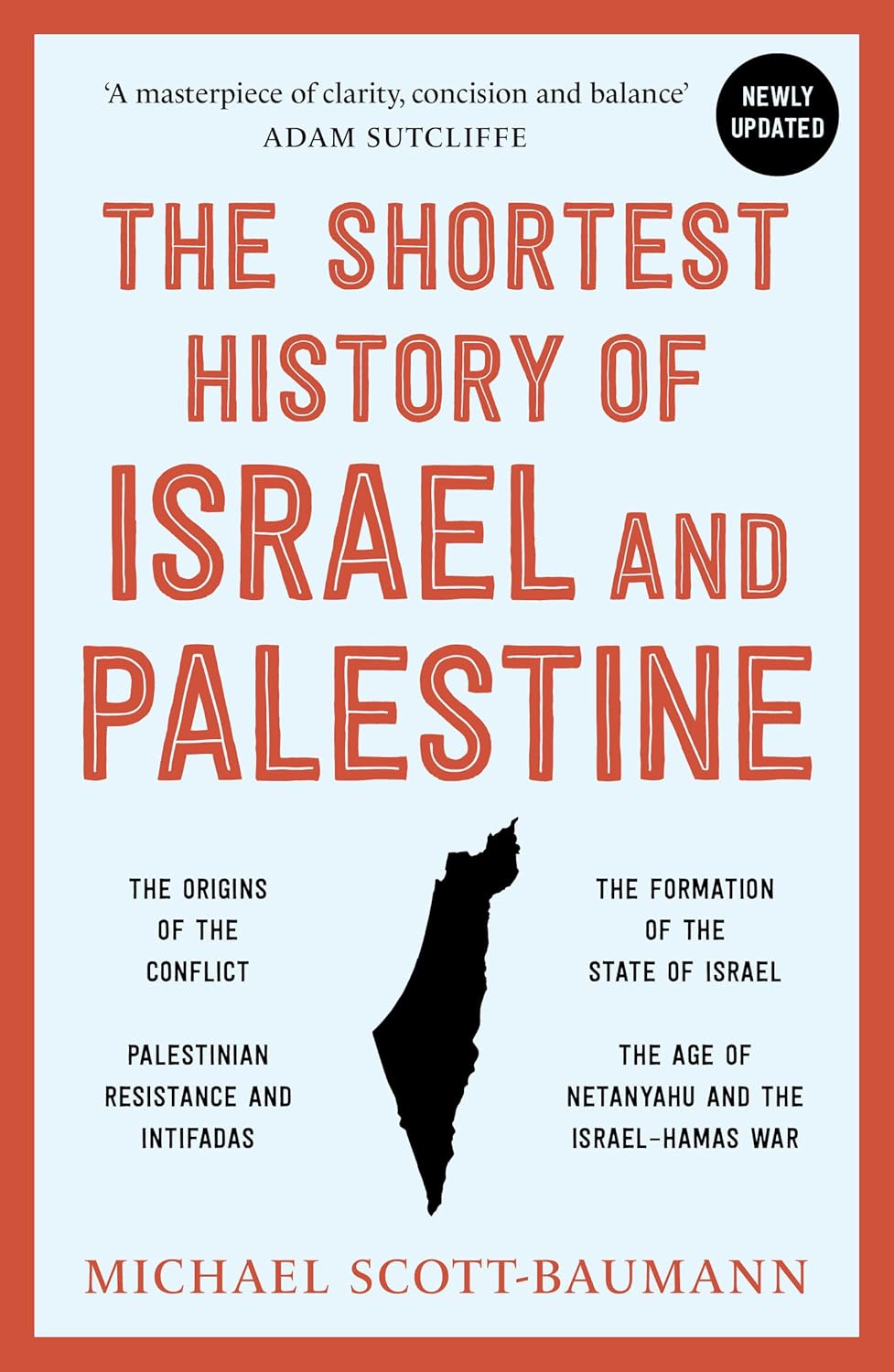Published on 16 April 2024, The Shortest History of Israel and Palestine by Michael Scott-Baumann is a compact yet powerful account of one of the world’s most enduring conflicts. Covering the journey from the late nineteenth century to recent decades, the book offers readers a clear view of how this struggle began and why it continues to shape global politics today.
What makes The Shortest History of Israel and Palestine especially valuable is its chronological storytelling. Beginning with Jewish migration in the late 1800s and moving through the foundation of Israel in 1948, the Arab-Israeli wars, the rise of the PLO, Operation Black Arrow, the Six-Day War, and the ongoing disputes in Gaza and the West Bank, the book provides a structured and balanced perspective. For anyone seeking to understand the roots of the Israel and Palestine conflict, this book is both timely and essential to read. Israel and Palestine are presented not just as political entities but as lands filled with people whose lives have been deeply shaped by war, displacement, and struggle.

The book does not cover pre-Ottoman Palestinian history in detail including Hamas attacks and stops before the October 7, 2023 attacks. Yet, even with these gaps, it succeeds in offering a structured and highly informative history of Israel and Palestine. The bibliography and resources included also encourage readers to explore more sources, reinforcing the idea that no single book can provide the full picture of such a contested history.
In The Shortest History of Israel and Palestine, Baumann also examines the role of international powers such as Britain and the United States, showing how colonial policies, foreign aid, and global politics influenced the region’s destiny. This broader lens allows readers to see the conflict not only as a regional struggle but also as part of a much larger geopolitical story.
By weaving together themes of Zionism, Palestinian resistance, human rights, and identity, The Shortest History of Israel and Palestine helps readers understand why peace has remained elusive. It is not just a historical overview but also a human story, highlighting how ordinary people have endured war, displacement, and decades of uncertainty.
Read Also: The Hero of Tiger Hill | Kargil War Memoir
Book Details and Availability

The Shortest History of Israel and Palestine by Michael Scott-Baumann was published on 9 January 2024 by AAJ Enterprises in association with Ignited Books. The book is written in English and is available in paperback format with 288 pages. Readers can purchase the book in Kindle edition for ₹270 and in paperback edition for ₹389. It is easily available on popular platforms like Amazon, Flipkart, and Goodreads, as well as in leading bookstores across India.
Read Also: How China Escaped the Poverty Trap | Book Review
About the Author of The Shortest History of Israel and Palestine
Michael Scott-Baumann is a historian, teacher, and writer with over 35 years of experience in making history accessible to students and general readers. A graduate of Cambridge University, he also holds an MA from the School of Oriental and African Studies (SOAS), London. He has travelled widely across the Middle East and even worked as a volunteer with the Israeli Committee Against House Demolitions, conducting field work in the West Bank. He currently lives in Cheltenham, England.
Alongside his teaching career, Michael Scott-Baumann has written several important history books and study guides that are valued for their clarity and depth. His works cover a wide range of subjects, including modern conflicts, social change, and civil rights. Some of his notable books include The Shortest History of Israel and Palestine (2023), Conflict in the Middle East, 1945–95, Civil Rights in the USA, 1865–1992, and contributions to the well-known Access to History series. His guides on Russia, Germany, Britain, and global wars have also been widely used by A-Level history students.
Through his writing, Michael Scott-Baumann has earned recognition for presenting complex historical events in a simple and engaging way. His works not only provide factual knowledge but also encourage readers to think critically about the forces that have shaped our world.
Read Also: Human Edge in the AI Age by Nitin Seth | Book Review
Themes in The Shortest History of Israel and Palestine

The Zionist movement began in Europe in the late 19th century, when Jewish communities facing discrimination, pogroms, and exclusion then they sought for a national homeland. By the early 1900s, tens of thousands of Jews had migrated to Palestine, then under Ottoman rule, and after the First World War, Jewish immigration increased under the British Mandate. The Holocaust of the 1940s, in which six million Jews were killed, gave a powerful urgency to the idea of a Jewish state, and international sympathy for Zionism grew stronger.
The book explains how Jewish communities across Europe, especially after centuries of persecution, saw Palestine as their promised land. At the same time, Palestinians viewed this rising movement with fear and resistance. Many Arabs who had lived in Palestine for centuries saw the growth of Zionist settlements as a threat to their homes, culture, and identity. This clash of hopes and fears shaped the destiny of Israel and Palestine.
- Historical Foundations of the Conflict: The Shortest History of Israel and Palestine begins by showing how the roots of the conflict go back more than a century. The roots of the Israel and Palestine conflict go back to the late 1800s, when Jewish migration to Ottoman-controlled Palestine increased. By 1914, the Jewish population had risen to about 85,000, while Arabs numbered over half a million. This demographic shift sowed early tensions that later became central to the conflict between Jews and Arabs in the region.
- Zionism and Palestinian Resistance: In The Shortest History of Israel and Palestine, a key theme is the rise of Zionism and the Palestinian response. Beginning in the late 19th century, Jews migrated to Palestine to seek safety from persecution, and after the Holocaust, the call for a Jewish homeland grew stronger. Palestinians, however, feared losing their land and identity, leading to uprisings such as the 1936–39 Arab revolt against British rule and Jewish migration showed how deep these fears had become. When the state of Israel was declared in 1948, around 700,000 Palestinians were displaced, an event they call the Nakba or “catastrophe.” This theme in The Shortest History of Israel and Palestine shows how two communities, each shaped by trauma and longing for security, were set on a collision course that still defines the conflict today.
- The Impact of British and International Decisions: The involvement of outside powers is explored in detail in The Shortest History of Israel and Palestine. The British Mandate, the Balfour Declaration (in 1917), and the United Nations partition plan all influenced the map of the Middle East. These decisions, often made without fully considering the people of Palestine, deepened divisions. The theme shows how Israel and Palestine were shaped not only by local struggles but also by international politics.
- Wars and Shifting Borders: One strong theme in The Shortest History of Israel and Palestine is the series of wars that changed boundaries and lives. The 1948 Arab-Israeli War and the Yom Kippur War are explained in simple terms. These conflicts expanded Israel’s territory but also created deep resentment among Palestinians. The theme highlights how wars constantly redrew the map of Israel and Palestine. In the Six-Day War of June 1967, Israel fought Egypt, Syria, and Jordan. In just six days, Israel captured the West Bank, Gaza Strip, Sinai Peninsula, and Golan Heights. This victory transformed the map of the region but also began the military occupation of Palestinian lands.
- Religion and Holy Sites: Jerusalem, home to the Al-Aqsa Mosque, the Western Wall, and the Church of the Holy Sepulchre, is central in The Shortest History of Israel and Palestine. Disputes over access and control of these sacred places fuel tension. Jerusalem and its holy sites are sacred to Jews, Christians, and Muslims alike. Religious identity adds another layer to the conflict, making compromises harder between Israel and Palestine.
- Uprisings and Resistance Movements: The Shortest History of Israel and Palestine also focuses on the Palestinian uprisings known as the Intifadas. These grassroots movements expressed anger at occupation and inequality. At the same time, Israel responded with strong military action. This theme explains how resistance and repression became part of daily life in Israel and Palestine, making peace harder to achieve. The First Intifada (1987–1993) saw Palestinians protesting Israeli occupation through strikes, boycotts, and clashes. The Second Intifada (2000–2005) was far more violent, with suicide bombings and harsh Israeli military responses. This book shows how these uprisings revealed Palestinian frustration and shaped global perceptions of the conflict.
- Displacement, Refugees, and Identity: The book gives special attention to the human cost of conflict in The Shortest History of Israel and Palestine. When Israel was created in 1948, hundreds of thousands of Palestinians were forced to leave their homes. Refugee camps became part of Palestinian life, while Israelis built a new identity centred on survival and security. This theme shows how the conflict is not only about politics but also about memory, exile, and belonging. Today, over 5.9 million Palestinians are registered as refugees with the UN, many living in camps in Lebanon, Jordan, and Syria. Generations have grown up stateless, while Israelis built a secure state. This human cost defines the struggle over Israel and Palestine.
- Peace Efforts and Broken Promises: Repeated attempts at peace form another important theme in The Shortest History of Israel and Palestine. The Oslo Accords, Camp David talks, and other negotiations created moments of hope, but most ended in disappointment. By exploring why peace deals failed, the book helps readers understand why Israel and Palestine are still searching for a solution. The 1917 Balfour Declaration by Britain supported a Jewish homeland, while the 1947 UN partition plan proposed separate states for Jews and Arabs. Later, the U.S. became Israel’s main ally, giving billions in military aid, while Arab states supported Palestinians. These global ties ensured the conflict remained international.
- Human Stories Amid Conflict: Beyond wars and treaties, The Shortest History of Israel and Palestine includes personal testimonies that bring the story to life. Ordinary people from both Israel and Palestine share experiences of displacement, fear, and resilience. This theme highlights how history is not only about leaders and armies but also about families, communities, and children growing up in conflict.
- The Uncertain Future: The final theme in The Shortest History of Israel and Palestine is the question of what lies ahead. Issues like Israeli settlements, Palestinian statehood, human rights, Gaza blockades, and clashes in the West Bank and security remain unresolved. As of 2023, over 700,000 Israeli settlers live in occupied territories, deepening disputes. The book ends by showing that the story of Israel and Palestine is still being written and struggle remain unresolved, with both sides facing challenges that demand courage, dialogue, and compromise with peace still uncertain.
Why This Book Deserves Your Attention
Read Also: In the Times of Love and Longing | Book Review
The Shortest History of Israel and Palestine is a must-read for anyone who wants to understand one of the world’s most complex and long-lasting conflicts in a clear and concise way. The book takes more than a century of history and presents it in short, easy-to-follow chapters, making it perfect for both beginners and those already familiar with the subject. It explains key events like the Balfour Declaration, the 1948 War, the Six-Day War, and the peace talks, while also highlighting the human stories of displacement, survival, and resistance.

The writing style of The Shortest History of Israel and Palestine is clear, simple, and engaging. The author avoids heavy academic jargon, making complex history easy to understand for general readers. Each chapter is short and to the point, presenting facts in a straightforward narrative that flows smoothly. The language is balanced and neutral, giving space to both Israeli and Palestinian perspectives without pushing a political agenda. Instead of long and confusing explanations, the book uses crisp sentences and well-organized sections that summarize more than a century of history in an accessible way as it turns complicated events into a story that is both informative and easy to follow.
Reading this book gives you a balanced perspective, cutting through political rhetoric and focusing on facts. Whether you are a student, researcher, educators or simply curious about global issues, this book helps you grasp the roots of the conflict and why it continues to affect world politics today. It is not only informative but also thought-provoking, encouraging readers to look at both Israeli and Palestinian experiences with empathy.
Final Thoughts
This book serves as a gateway to understanding one of the world’s most difficult conflicts. Instead of overwhelming the reader with dense detail, it presents history in short, precise chapters that highlight both the events and the human stories behind them. The tone remains neutral, giving equal weight to Israeli and Palestinian experiences while showing why peace has been so difficult to achieve. Readers come away not just with knowledge of wars, treaties, and migrations, but also with a deeper awareness of the emotions, losses, and resilience that continue to shape the region’s past and present.
Read Also: Aghori: An Untold Story | Mayur Kalbag | Book Review




